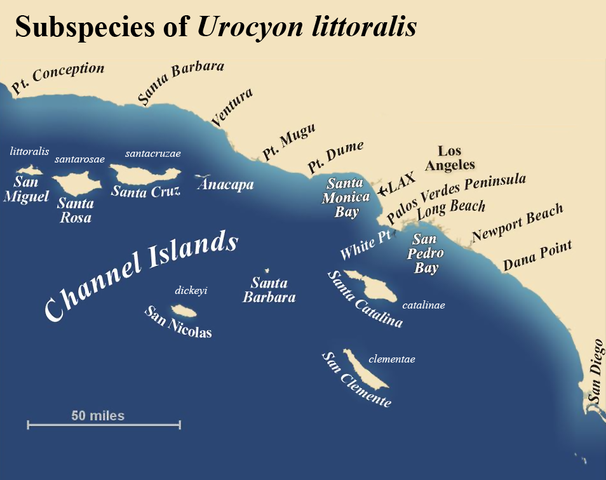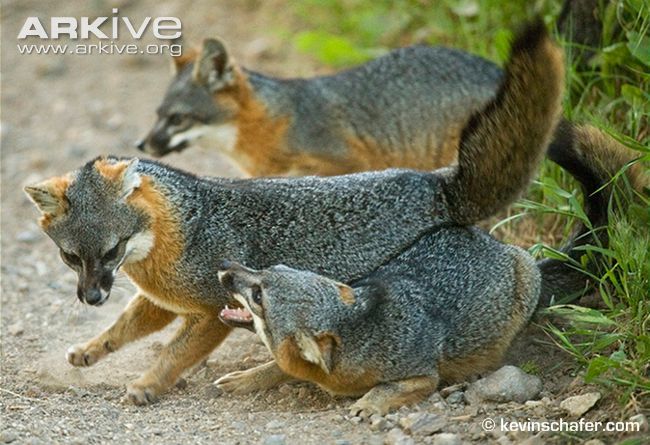Вы не зашли.
Объявление
"Давайте только проявлять больше внимания, терпимости и уважения к чужому мнению — вот и всё." — Gennadius.
— О размещении изображений на форуме, О рекламе на форуме
#1 05 April 2016 19:47:32
- Wolf
- Без пяти минут зоолог

- Зарегистрирован: 13 January 2009
- Сообщений: 2583
Островная лисица
В эволюционном отношении островная лисица является боковой линией серой лисицы, отделившейся после того, как во время последнего ледникового периода серые лисицы попали на острова Чаннел. Островные лисицы значительно меньше своих предков, их величина соответствует размеру домашней кошки. Они являются типичным примером островной карликовости.
Because the island fox is geographically isolated, it has no immunity to parasites and diseases brought in from the mainland and is especially vulnerable to those the domestic dog may carry.
Всего 6 подвидов, каждый на "своем" острове:
Urocyon littoralis littoralis of San Miguel Island,
Urocyon littoralis santarosae of Santa Rosa Island,
Urocyon littoralis santacruzae of Santa Cruz Island,
Urocyon littoralis dickeyi of San Nicolas Island,
Urocyon littoralis catalinae of Santa Catalina and,
Urocyon littoralis clementae of San Clemente Island.
Foxes from each island are capable of interbreeding, but have genetic and phenotypic distinctions that make them unique; for example, the subspecies have differing numbers of tail vertebrae.
The island fox is significantly smaller than the gray fox and perhaps the smallest fox in North America, averaging slightly smaller than the swift and kit foxes. Typically the head-and-body length is 48–50 cm (18–20 in.), shoulder height 12–15 cm (4–6 in.), and the tail is 11–29 cm (4–11 in.) long, which is notably shorter than the 27–44 cm (10–17 in.) tail of the gray fox. This is due to the fact that the island fox generally has two fewer tail vertebrae than the gray fox. The island fox weighs between 1 and 2.8 kg (2.2 and 6.2 lb). The male is always larger than the female. The largest of the subspecies occurs on Santa Catalina Island and the smallest on Santa Cruz Island.
The island fox has gray fur on its head, a ruddy red coloring on its sides, white fur on its belly, throat and the lower half of its face, and a black stripe on the dorsal surface of its tail. In general the coat is darker and duller hued than that of the gray fox. The island fox molts once a year between August and November. Before the first molt pups are woolly and have a generally darker coat than adult foxes.
The island fox typically forms monogamous breeding pairs which are frequently seen together beginning in January and through the breeding season, from late February to early March. The gestation period is 50–63 days. The female island fox gives birth in a den, a typical litter having one to five pups, with an average of two or three. Pups are born in the spring and emerge from the den in early summer; the mother lactates for 7–9 weeks. Sexual maturity is reached at 10 months, and the females usually breed within the first year. Island foxes live for 4–6 years in the wild and for up to 8 years in captivity.
Its preferred habitat is complex layer vegetation with a high density of woody, perennially fruiting shrubs. The fox lives in all of the island biomes including temperate forest, temperate grassland and chaparral, with no island supporting more than 1,000 foxes. The island fox eats fruits, insects, birds, eggs, crabs, lizards, and small mammals, including deer mice. The fox tends to move around by itself, rather than in packs. It is generally nocturnal, albeit with peaks of activity at dawn and dusk. Activity also fluctuates with the season; it is more active during the day in summer than it is in winter.
The island fox is not intimidated by humans, although at first may show aggression. It is quite easy to tame and is generally docile. The island fox communicates using auditory, olfactory and visual signals. A dominant fox uses vocalizations, staring, and ear flattening to cause another fox to submit. Signs of dominance and submission are visual, such as facial expression and body posture. Its main vocalizations are barking and growling. The island fox marks territory with urine and feces.



Per aspera ad astra
Неактивен
#2 05 April 2016 19:49:07
- Wolf
- Без пяти минут зоолог

- Зарегистрирован: 13 January 2009
- Сообщений: 2583
Re: Островная лисица
Я так понимаю, ничем, кроме размеров, от серой лисицы не отличаются?
Per aspera ad astra
Неактивен
#3 05 April 2016 19:55:22
- Wolf
- Без пяти минут зоолог

- Зарегистрирован: 13 January 2009
- Сообщений: 2583
Re: Островная лисица
Черепа серой и островной лисиц:
Per aspera ad astra
Неактивен
#4 05 April 2016 20:52:23
- Crazy Zoologist
- Гость
Re: Островная лисица

#5 05 April 2016 21:10:25
- Wolf
- Без пяти минут зоолог

- Зарегистрирован: 13 January 2009
- Сообщений: 2583
Re: Островная лисица
Wolf :
Я так понимаю, ничем, кроме размеров, от серой лисицы не отличаются?
Per aspera ad astra
Неактивен
#6 05 April 2016 21:11:20
- Crazy Zoologist
- Гость
Re: Островная лисица
Просто очень похожий вид.
#7 05 April 2016 21:12:33
- Wolf
- Без пяти минут зоолог

- Зарегистрирован: 13 January 2009
- Сообщений: 2583
Re: Островная лисица
Ну а какие-то отличия, кроме размера есть? Видимо, нет. Ведь, по сути, островная лисица - это просто островной-карликовый вариант серой лисицы.
Per aspera ad astra
Неактивен
#8 05 April 2016 21:14:06
- Crazy Zoologist
- Гость
Re: Островная лисица
Наверное генетические.
#9 06 April 2016 01:56:39
- Wolf
- Без пяти минут зоолог

- Зарегистрирован: 13 January 2009
- Сообщений: 2583
Re: Островная лисица
Ну, генетика по любому. Я имел ввиду морфологические различия.
Per aspera ad astra
Неактивен
#10 06 April 2016 02:23:13
- Crazy Zoologist
- Гость
Re: Островная лисица
У серой видер сагиттальный гребень.
#11 06 April 2016 02:26:14
- Wolf
- Без пяти минут зоолог

- Зарегистрирован: 13 January 2009
- Сообщений: 2583
Re: Островная лисица
Ну и еще позвонки хвоста:
This is due to the fact that the island fox generally has two fewer tail vertebrae than the gray fox.
Значит хвост пропорционально короче.
Отредактировано Wolf (06 April 2016 02:26:58)
Per aspera ad astra
Неактивен
#12 12 April 2016 04:01:32
- Wolf
- Без пяти минут зоолог

- Зарегистрирован: 13 January 2009
- Сообщений: 2583
Re: Островная лисица
Недавно наткнулся на упоминание новой научной статьи по островной лисице:
W. Chris Funk, Robert E. Lovich, Paul A. Hohenlohe, Courtney A. Hofman, Scott A. Morrison, T. Scott Sillett, Cameron K. Ghalambor, Jesus E. Maldonado, Torben C. Rick, Mitch D. Day, Nicholas R. Polato, Sarah W. Fitzpatrick, Timothy J. Coonan, Kevin R. Crooks, Adam Dillon, David K. Garcelon, Julie L. King, Christina L. Boser, Nicholas Gould, William F. Andelt. Adaptive divergence despite strong genetic drift: genomic analysis of the evolutionary mechanisms causing genetic differentiation in the island fox (Urocyon littoralis). Molecular Ecology, 2016; DOI: 10.1111/mec.13605
Короче говоря, подвид островной лисицы острова San Nicolas под угрозой исчезновения в связи с очень низкой генетической вариацией (самая низкая среди всех видов млекопитающих). При всем этом, осталось менее 300 представителей этого подвида. Поэтому ученные хотят заселить остров другими подвидами островной лисицы, чтобы увеличить генетический фонд лисиц острова San Nicolas.
http://onlinelibrary.wiley.com/doi/10.1 … 5/abstract
Per aspera ad astra
Неактивен
#13 12 April 2016 09:59:10
- Crazy Zoologist
- Гость
Re: Островная лисица
(самая низкая среди всех видов млекопитающих). При всем этом, осталось менее 300 представителей этого подвида.
А амурских леопардов ведь меньше?
#14 12 April 2016 12:22:54
- Wolf
- Без пяти минут зоолог

- Зарегистрирован: 13 January 2009
- Сообщений: 2583
Re: Островная лисица
Судя по всему - нет. Кстати, сколько особей амурских леопардов осталось в природе?
Per aspera ad astra
Неактивен
#15 12 April 2016 12:36:00
- Crazy Zoologist
- Гость
Re: Островная лисица
Не знаю, было 30. Причем долгое время популяция была стабильной, щас не знаю, интересуюсь только персидскими и любыми леопардами из джунглей, особенно Африки и Индии.
Как такое может быть не понимаю, инбридинг же оголтелый.
#16 12 April 2016 12:50:03
- Wolf
- Без пяти минут зоолог

- Зарегистрирован: 13 January 2009
- Сообщений: 2583
Re: Островная лисица
The San Nicolas Island fox has the lowest genetic variation ever found in a mammal species, making them especially vulnerable.
Per aspera ad astra
Неактивен